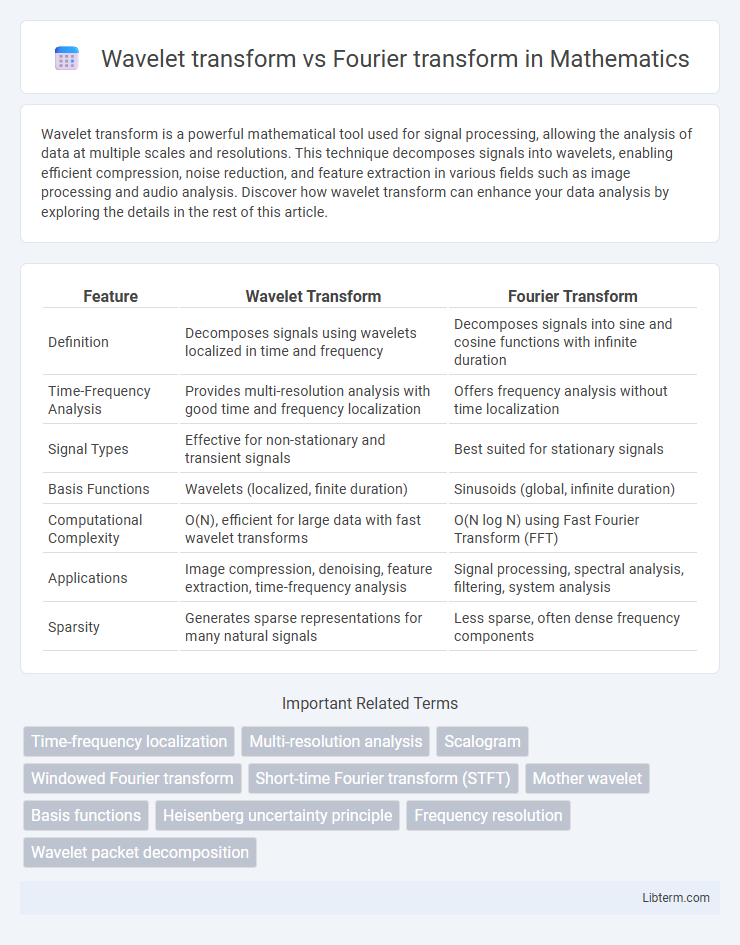Wavelet transform is a powerful mathematical tool used for signal processing, allowing the analysis of data at multiple scales and resolutions. This technique decomposes signals into wavelets, enabling efficient compression, noise reduction, and feature extraction in various fields such as image processing and audio analysis. Discover how wavelet transform can enhance your data analysis by exploring the details in the rest of this article.
Table of Comparison
| Feature | Wavelet Transform | Fourier Transform |
|---|---|---|
| Definition | Decomposes signals using wavelets localized in time and frequency | Decomposes signals into sine and cosine functions with infinite duration |
| Time-Frequency Analysis | Provides multi-resolution analysis with good time and frequency localization | Offers frequency analysis without time localization |
| Signal Types | Effective for non-stationary and transient signals | Best suited for stationary signals |
| Basis Functions | Wavelets (localized, finite duration) | Sinusoids (global, infinite duration) |
| Computational Complexity | O(N), efficient for large data with fast wavelet transforms | O(N log N) using Fast Fourier Transform (FFT) |
| Applications | Image compression, denoising, feature extraction, time-frequency analysis | Signal processing, spectral analysis, filtering, system analysis |
| Sparsity | Generates sparse representations for many natural signals | Less sparse, often dense frequency components |
Introduction to Signal Transformation Techniques
Wavelet transform offers localized time-frequency analysis by decomposing a signal into scaled and shifted wavelets, making it ideal for non-stationary signal processing. Fourier transform breaks down a signal into infinite sinusoidal components, providing global frequency information but lacking time localization. Both techniques serve critical roles in signal transformation, with wavelets excelling in transient detection and Fourier excelling in steady-state frequency analysis.
Understanding Fourier Transform
Fourier Transform decomposes a signal into its constituent sinusoidal frequencies, providing a global frequency spectrum that is ideal for stationary signals with constant frequency content. It converts time-domain data into frequency-domain representation, enabling analysis of signal frequency components but without time localization. This makes Fourier Transform less effective for non-stationary signals where frequency components vary over time, a limitation addressed by Wavelet Transform through time-frequency localization.
Understanding Wavelet Transform
Wavelet transform analyzes signals at multiple scales, providing localized time-frequency information unlike the Fourier transform, which only offers global frequency content. This enables effective detection of transient features and non-stationary signals, making wavelets ideal for applications in image compression, seismic analysis, and biomedical signal processing. Wavelet transform uses basis functions called wavelets, which vary in scale and position, allowing detailed signal decomposition and reconstruction with high resolution in both time and frequency domains.
Mathematical Foundations: Wavelet vs. Fourier
Wavelet transform decomposes signals into scaled and shifted versions of a mother wavelet, allowing localized time-frequency analysis using basis functions with finite support. Fourier transform represents signals as sums of sinusoids over infinite time intervals, providing global frequency information without temporal localization. Mathematically, wavelets use multiresolution analysis and orthogonal function spaces, whereas Fourier relies on orthogonal complex exponentials forming a complete basis in L2 space.
Time-Frequency Localization Comparison
Wavelet transform offers superior time-frequency localization compared to Fourier transform by providing multi-resolution analysis, allowing detailed examination of signals at various scales and positions. Fourier transform excels in frequency resolution but lacks precise time localization, as it assumes signal stationarity and uses infinite-length sinusoids. Wavelet transform's ability to capture transient features and non-stationary signals makes it highly effective for time-frequency analysis in fields such as biomedical signal processing and seismic data interpretation.
Application Areas of Fourier Transform
Fourier transform is widely used in signal processing, image analysis, and communication systems for frequency domain analysis of signals. It plays a crucial role in audio and speech recognition, spectral analysis, and filtering techniques. Additionally, Fourier transform is essential in medical imaging modalities such as MRI and CT scans for reconstructing images from raw data.
Application Areas of Wavelet Transform
Wavelet transform excels in applications requiring time-frequency localization, such as image compression, denoising, and feature extraction in signal processing, where Fourier transform's global frequency analysis is insufficient. It is widely used in medical imaging, geophysics, and financial data analysis due to its multi-resolution capabilities and ability to handle non-stationary signals. This makes wavelet transform particularly effective for transient event detection, texture analysis, and real-time signal processing tasks.
Advantages of Wavelet Transform over Fourier
Wavelet transform offers superior time-frequency localization compared to Fourier transform, making it ideal for analyzing non-stationary signals with transient features. Its ability to provide multi-resolution analysis enables better detection of signal singularities and abrupt changes. Unlike Fourier transform, wavelet transform adapts to different scales, enhancing signal processing accuracy in applications like image compression and biomedical signal analysis.
Limitations and Challenges of Each Method
Wavelet transform faces limitations in frequency resolution, making it less effective for analyzing signals with stationary frequencies compared to Fourier transform, which excels in frequency domain representation but lacks time localization for non-stationary signals. Fourier transform's challenge lies in its assumption of signal stationarity, leading to poor performance in transient and time-varying signal analysis. Wavelet transform requires careful selection of wavelet functions and scales, adding complexity and computational cost in practical applications.
Choosing Between Wavelet and Fourier Transforms
Choosing between wavelet and Fourier transforms depends on the signal characteristics and analysis goals. Wavelet transform excels in analyzing non-stationary signals with localized time-frequency features, offering multi-resolution analysis for transient or time-varying data. Fourier transform is optimal for stationary signals with global frequency content, providing precise frequency information but lacking time localization.
Wavelet transform Infographic

 libterm.com
libterm.com